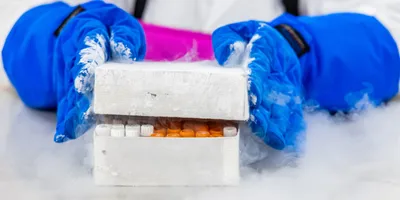Ultra-low temperature storage (ULT) has gone from a relatively niche industry term for the life sciences space to a commonplace acronym in the course of a year. ULT storage became the foundational requirement for distribution of the Moderna and Pfizer COVID-19 vaccines in 2020. However, the concept of ULT storage exists, first and foremost, out of the need to slow or halt bioprocessing in laboratory samples for clinical testing, research, and development. The colder the environment, the slower molecules and biological proteins move, react, or change, making them easier to observe and study over longer periods of time.
A year into the pandemic, many laboratories, biorepositories, and stakeholders throughout the life sciences supply chain will find themselves with at least one ULT freezer acquired for the express purpose of supporting vaccine distribution. Those with pre-pandemic experience leveraging ULT freezers will likely return to their utilization for sample storage purposes, while others may be weighing the opportunities to extend their return on investment after the pandemic. Here is a look at improvements in ULT storage and how they will support the future of medicine.
Springboard the future of mRNA and precision medicine
The resounding success of mRNA vaccines at scale, in tandem with a flux of new capital for the scientific community, have inspired new confidence to explore and deliver treatments in the areas of mRNA and precision medicines. Researchers are already exploring further applications for mRNA vaccines going forward. Furthermore, the realizations of the COVID-19 vaccine effort have invigorated interest and confidence in delivering more complex precision medicines to cure cancers, rare diseases, and more, while mitigating widespread side effects that can occur with blockbuster treatments.
In order to deliver more complex and personalized precision medicine, their stability must be guaranteed throughout the supply chain. As such, all precision medicine will likely need some degree of ULT storage to maintain their efficacy. These storage requirements may vary greatly due to the formulation of each individual treatment. Maximum flexibility of ULT storage will be crucial to support the stability requirements, whatever they might be, as well as to mitigate lengthy stability testing requirements.
The confluence of greater reliability, visibility, and flexibility in ULT storage across the supply chain will provide a long-term foundation for researchers to confidently deliver new classes of medicine, especially precision medicine, at scale. These concepts that were once dismissed as an industry pipe dream will be accessible for public consumption, likely in our lifetime—thanks in part to the ULT infrastructure erected to end the COVID-19 pandemic.
Provide more reliable storage of biological specimens
The most critical near-term applications for ULT storage will be around laboratory specimen and active pharmaceutical ingredient storage. Treatments and vaccines are composed of active pharmaceutical ingredients (APIs) that elicit their effects, and excipient ingredients, which help facilitate delivery into the patient’s system. Test specimens, tissue, and blood samples needed to produce APIs all require ULT storage to maintain efficacy. Furthermore, bulk storage facilities for APIs face stringent regulations and oversight to maintain the efficacy of the materials they are storing.
As a result, researchers and manufacturers depend heavily on the continuous reliability of their ULT storage to enforce the quality and compliance of their products. When freezers or their power sources fail, the cost is not only financial. Oftentimes, the specimens will be irreplaceable. Fortunately, ULT storage is becoming more robustly equipped for the unexpected with onboard fail-safe capabilities, should typical energy sources fail. In tandem with better laboratory practices and routine maintenance to mitigate emergencies, ULT manufacturers are exploring ways to increase hold times at sustained subzero temperatures, whether for portability to move products easily from location to location, or to sustain temperatures in the event of a power outage.
Advanced Lab Management Certificate
The Advanced Lab Management certificate is more than training—it’s a professional advantage.
Gain critical skills and IACET-approved CEUs that make a measurable difference.
Power more connected supply chains
Today, the pharmaceutical industry loses approximately $35B annually as a result of failures in cold chain logistics. When it comes to ULT freezers, it is often not a sudden blackout that leads to product or sample loss, but human error. Employees leave a door open for too long sorting through frozen samples, potentially letting too much warm air contact freezer contents and compromise their stability.
The vaccine distribution effort for COVID-19, in particular, has shone a light on the critical pitfalls in the pharmaceutical cold chain perpetuated by lack of visibility. Stakeholders across the supply chain were faced head-on with the imperative to address the blind spots to mitigate losses from missed handoffs, theft, product spoilage, re-testing, and compliance issues. Beyond the pandemic, there will be an imperative for ULT storage to undergo digital transformation to incorporate capabilities that support tracking and visualization of not just freezers, but individual samples or vials. These capabilities will become an essential requirement of ULT freezers to support the maturation of the increasingly complex and high-value pharmaceutical cold chain.
Improve sustainability in life sciences
Beyond efficiency, the life sciences supply chain has another prevalent issue to address: its massive carbon footprint. With the exception of data centers, laboratories consume more energy per floor space than any other type of life sciences facility. What’s more, ULT freezers are the most energy-intensive piece of lab equipment, next to fume hoods. The increased utilization of natural refrigerants for ULT storage over high-GWP F-Gas refrigerants will contribute to lower carbon footprints and energy costs for labs. The implementation of these better environmental practices will lower energy costs and free up funds to be reinvested in research that drives medical innovation, in addition to contributing to the betterment of our world.












